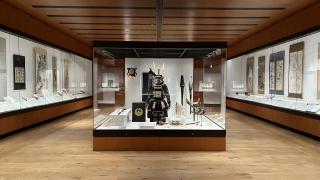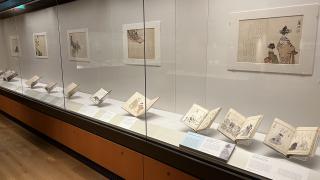-
A Special Display at the British Museum Showcases Research Outcomes of the International Joint Research Project 'Creative Collaborations: Salons and Networks in Kyoto and Osaka 1780-1880'May 9, 2024(Thu)
The Art Research Center (ARC), Ritsumeikan University, is pleased to announce that a one-year Special Display at the British Museum in London is currently showcasing the research outcomes of the international joint research project 'Creative Collaborations: Salons and Networks in Kyoto and Osaka 1780-1880 (上方文化サロン:人的ネットワークから解き明かす文化創造空間 1780-1880),' supported by UK Research & Innovation (UKRI) and the Japan Society for the Promotion of Science (JSPS).
This research project, led by the Principal Investigators (PI) Prof. Ryo Akama (Director of the ARC/College of Letters, Ritsumeikan University) and Dr. Akiko Yano (Curator, Department of Asia, British Museum), aims to investigate the cultural and social impact of art and literary salons and the collective creation of art (gassaku) in early modern Japan, particularly in the Kyoto-Osaka region circa 1780-1880 by analysing over 5,000 objects in collections at the British Museum and in Japan.
During the course of this project, these works have been digitally archived and their textual inscriptions transcribed into an extensive online research database--the 'Kamigata Bunkajin Sogo Database' (「上方文化人総合データベース」)--established and operated by the ARC, providing a new portal for research on early modern Japanese culture with the possibility of incorporating other collections on different themes in the future.
→ARC Virtual Institute: Salons and Networks in Kyoto and Osaka
Addressing the challenges presented by COVID-19, the project has been exemplary in how a Japan-UK collaborative research project, comprised of a team of researchers from the Art Research Center (ARC), Kansai University (KU), the National Museum of Modern Art, Kyoto, the British Museum (BM), and SOAS, University of London, can be conducted efficiently using digital online technologies for remote collaboration.
The project has also fostered early-career researchers in Japanese studies by providing an opportunity for them to gain hands-on experience in the fundamental aspects of digital humanities within an international research environment.
This project was supported by the JSPS International Joint Research Programme (JRP-LEAD with UKRI) [JPJSJRP 20211708].
Project duration: December 1, 2021 - November 30, 2024 (3 years).
Related article: https://www.britishmuseum.org/research/projects/making-art-together-japan
[Official release from the British Museum]
Special display
City Life and Salon Culture in Kyoto and Osaka, 1770-1900Rooms 93 and 94, Mitsubishi Corporation Japanese Galleries (free admission)
First rotation: 6 April 2024 - 6 October 2024 (TBC)
Second rotation: 10 October 2024 (TBC) - March 2025Kyoto and Osaka were two major cities in Japan during the Edo period (1603-1868). Kyoto was the imperial capital, while Osaka was the centre of domestic trade. The seat of the samurai government was in Edo (present-day Tokyo).
Education and the arts flourished in all three cities. New artistic styles, technology and science developed. These dynamic trends were stimulated not just through Japanese ingenuity, but also due to contact with the wider world via Nagasaki, the only international port during this time.
In these cities and beyond, people - both professional and amateur - came together to practise hobbies, from poetry, painting and music to gardening and tea ceremony. Within these cultural spaces, or 'salons', official class distinctions were set aside and people collaborated on equal terms. This ethos was the basis of cultural vibrancy across Japanese society from the late 1700s.
Despite Japan's political turmoil and change from the 1860s, the practice and spirit of 'salons' continued until at least the beginning of the 1900s.
This special display draws on the British Museum's rich and deep collection of Japanese art to uncover the lively energy of salon culture in Kyoto and Osaka. The display includes paintings, prints, books and beautifully crafted objects that reflect the latest artistic trends at the time and showcase contemporary Japanese people's delight in all forms of cultural activity.
Topics covered in the special display include:
Kyoto: the evolving ancient capital of Japan
Osaka: the centre of commerce and curious minds
Nagasaki: gateway to the outside world
Hobbies and collaborative artistic works
Popular forms of poetry and surimono
Bunjin: adoration of Chinese literati ideals
Sencha: tea as elegant pastimeThis display is one of the outcomes of a three-year international research project exploring salon culture in Kyoto and Osaka, funded by UK Research and Innovation through the Economic and Social Science Research Council, and by the Japan Society for the Promotion of Science.
To coincide with the display, a richly illustrated publication, Salon culture in Japan: making art, 1750 to 1900, edited by Akiko Yano, will be published by the British Museum Press in June 2024. (Priced at £30)















